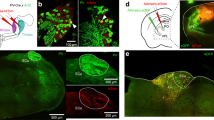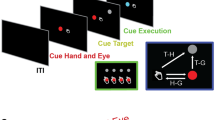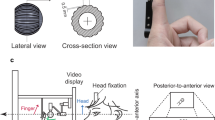Abstract
The cerebral cortex must have access to an eye position signal, as humans can report passive changes in eye position in total darkness, and visual responses in many cortical areas are modulated by eye position. The source of this signal is unknown. Here we demonstrate a representation of eye position in monkey primary somatosensory cortex, in the representation of the trigeminal nerve, near cells with a tactile representation of the contralateral brow. The neurons have eye position signals that increase monotonically with increasing orbital eccentricity from near the center of gaze, with directionally selectivity tuned in a Gaussian manner. All directions of eye position are represented in a single hemisphere. The signal is proprioceptive, because it can be obliterated by anesthetizing the contralateral orbit. It is not related to foveal or peripheral visual stimulation, and it represents the position of the eye in the head and not the angle of gaze in space.
This is a preview of subscription content, access via your institution
Access options
Subscribe to this journal
Receive 12 print issues and online access
$209.00 per year
only $17.42 per issue
Buy this article
- Purchase on Springer Link
- Instant access to full article PDF
Prices may be subject to local taxes which are calculated during checkout







Similar content being viewed by others
References
Skavenski, A.A. Inflow as a source of extraretinal eye position information. Vision Res. 12, 221–229 (1972).
Sakata, H., Shibutani, H. & Kawano, K. Spatial properties of visual fixation neurons in posterior parietal association cortex of the monkey. J. Neurophysiol. 43, 1654–1672 (1980).
Andersen, R.A. & Mountcastle, V.B. The influence of the angle of gaze upon the excitability of the light-sensitive neurons of the posterior parietal cortex. J. Neurosci. 3, 532–548 (1983).
Mullette-Gillman, O.A., Cohen, Y.E. & Groh, J.M. Eye-centered, head-centered, and complex coding of visual and auditory targets in the intraparietal sulcus. J. Neurophysiol. 94, 2331–2352 (2005).
Nakamura, K. & Colby, C.L. Updating of the visual representation in monkey striate and extrastriate cortex during saccades. Proc. Natl. Acad. Sci. USA 99, 4026–4031 (2002).
van Opstal, A.J., Hepp, K., Suzuki, Y. & Henn, V. Influence of eye position on activity in monkey superior colliculus. J. Neurophysiol. 74, 1593–1610 (1995).
Lal, R., Friedlander, M.J. & Brunet, P. Effect of passive eye position changes on retinogeniculate transmission in the cat. J. Neurophysiol. 63, 502–522 (1990).
Rose, D. The historical roots of the theories of local signs and labelled lines. Perception 28, 675–685 (1999).
Campos, M., Cherian, A. & Segraves, M.A. Effects of eye position upon activity of neurons in macaque superior colliculus. J. Neurophysiol. 95, 505–526 (2006).
Duhamel, J.-R., Colby, C.L. & Goldberg, M.E. The updating of the representation of visual space in parietal cortex by intended eye movements. Science 255, 90–92 (1992).
Sommer, M.A. & Wurtz, R.H. A pathway in primate brain for internal monitoring of movements. Science 296, 1480–1482 (2002).
Krubitzer, L., Huffman, K.J., Disbrow, E. & Recanzone, G. Organization of area 3a in macaque monkeys: contributions to the cortical phenotype. J. Comp. Neurol. 471, 97–111 (2004).
Donaldson, I.M. The functions of the proprioceptors of the eye muscles. Phil. Trans. R. Soc. Lond. B 355, 1685–1754 (2000).
Buttner-Ennever, J.A. & Horn, A.K. The neuroanatomical basis of oculomotor disorders: the dual motor control of extraocular muscles and its possible role in proprioception. Curr. Opin. Neurol. 15, 35–43 (2002).
Eberhorn, A.C., Horn, A.K., Fischer, P. & Buttner-Ennever, J.A. Proprioception and palisade endings in extraocular eye muscles. Ann. NY Acad. Sci. 1039, 1–8 (2005).
Porter, J.D., Guthrie, B.L. & Sparks, D.L. Innervation of monkey extraocular muscles: localization of sensory and motor neurons by retrograde transport of horseradish peroxidase. J. Comp. Neurol. 218, 208–219 (1983).
Wurtz, R.H. Visual receptive fields of striate cortex neurons in awake monkeys. J. Neurophysiol. 32, 727–742 (1969).
Richmond, B.J. & Wurtz, R.H. Vision during saccadic eye movements. II. A corollary discharge to monkey superior colliculus. J. Neurophysiol. 43, 1156–1167 (1980).
Phillips, C.G., Powell, T.P. & Wiesendanger, M. Projection from low-threshold muscle afferents of hand and forearm to area 3a of baboon's cortex. J. Physiol. (Lond.) 217, 419–446 (1971).
Taylor, A., Durbaba, R., Ellaway, P.H. & Rawlinson, S. Static and dynamic gamma-motor output to ankle flexor muscles during locomotion in the decerebrate cat. J. Physiol. (Lond.) 571, 711–723 (2006).
Wise, S.P. & Tanji, J. Neuronal responses in sensorimotor cortex to ramp displacements and maintained positions imposed on hindlimb of the unanesthetized monkey. J. Neurophysiol. 45, 482–500 (1981).
Widener, G.L. & Cheney, P.D. Effects on muscle activity from microstimuli applied to somatosensory and motor cortex during voluntary movement in the monkey. J. Neurophysiol. 77, 2446–2465 (1997).
Henn, V., Lang, W., Hepp, K. & Reisine, H. Experimental gaze palsies in monkeys and their relation to human pathology. Brain 107, 619–636 (1984).
Guthrie, B.L., Porter, J.D. & Sparks, D.L. Corollary discharge provides accurate eye position information to the oculomotor system. Science 221, 1193–1195 (1983).
Lewis, R.F., Gaymard, B.M. & Tamargo, R.J. Efference copy provides the eye position information required for visually guided reaching. J. Neurophysiol. 80, 1605–1608 (1998).
Gauthier, G.M., Nommay, D. & Vercher, J.L. The role of ocular muscle proprioception in visual localization of targets. Science 249, 58–61 (1990).
Steinbach, M.J. Inflow as a long-term calibrator of eye position in humans. Acta Psychol. (Amst.) 63, 297–306 (1986).
Lewis, R.F., Zee, D.S., Gaymard, B.M. & Guthrie, B.L. Extraocular muscle proprioception functions in the control of ocular alignment and eye movement conjugacy. J. Neurophysiol. 72, 1028–1031 (1994).
Steinbach, M.J. Proprioceptive knowledge of eye position. Vision Res. 27, 1737–1744 (1987).
Dengis, C.A., Steinbach, M.J. & Kraft, S.P. Registered eye position: short- and long-term effects of botulinum toxin injected into eye muscle. Exp. Brain Res. 119, 475–482 (1998).
Robinson, D.A. Oculomotor unit behavior in the monkey. J. Neurophysiol. 33, 393–404 (1970).
Snyder, L.H., Grieve, K.L., Brotchie, P. & Andersen, R.A. Separate body- and world-referenced representations of visual space in parietal cortex. Nature 394, 887–891 (1998).
Zipser, D. & Andersen, R.A. A back-propagation programmed network that simulates response properties of a subset of posterior parietal neurons. Nature 331, 679–684 (1988).
Pouget, A., Deneve, S. & Sejnowski, T.J. Frames of reference in hemineglect: a computational approach. Prog. Brain Res. 121, 81–97 (1999).
Salinas, E. & Abbott, L.F. Transfer of coded information from sensory to motor networks. J. Neurosci. 15, 6461–6474 (1995).
Klier, E.M., Wang, H. & Crawford, J.D. Three-dimensional eye-head coordination is implemented downstream from the superior colliculus. J. Neurophysiol. 89, 2839–2853 (2003).
Duhamel, J.R., Goldberg, M.E., Fitzgibbon, E.J., Sirigu, A. & Grafman, J. Saccadic dysmetria in a patient with a right frontoparietal lesion. The importance of corollary discharge for accurate spatial behaviour. Brain 115, 1387–1402 (1992).
Judge, S.J., Richmond, B.J. & Chu, F.C. Implantation of magnetic search coils for measurement of eye position: an improved method. Vision Res. 20, 535–538 (1980).
Hays, A.V., Richmond, B.J. & Optican, L.M. A UNIX-based multiple process system for real-time data acquisition and control. WESCON Conference Proceedings 2, 1–10 (1982).
Bisley, J.W. & Goldberg, M.E. Neuronal activity in the lateral intraparietal area and spatial attention. Science 299, 81–86 (2003).
Bisley, J.W., Krishna, B.S. & Goldberg, M.E. A rapid and precise on-response in posterior parietal cortex. J. Neurosci. 24, 1833–1838 (2004).
Acknowledgements
We are grateful to H. Eggers for teaching us how to perform retrobulbar blocks, G. Duncan for electronic and computer support, Y. Pavlova for dedicated animal maintenance, M. Osman and G. Asfaw for veterinary care, S. Dashnaw and J. Hirsch for MRI, and L. Palmer for facilitating everything. This research was supported by grants from the James S. McDonnell Foundation, the US National Eye Institute (1 R01 EY014978-01 and 1 R24 EY015634-01), and the Whitehall, Keck, Dana and Kavli Foundations.
Author information
Authors and Affiliations
Contributions
X.W. and M.W. recorded all the neural activity, did much of the data analysis and made the figures. I.S.C. wrote many of the data analysis programs and did some of the preliminary data analysis. M.E.G. dreamed up the project, worked out the retrobulbar block technique with H. Eggers and supervised the entire project.
Corresponding author
Ethics declarations
Competing interests
The authors declare no competing financial interests.
Supplementary information
Supplementary Table 1
Effect of eye eccentricity on cell response. (PDF 37 kb)
Supplementary Table 2
The effect of the retrobulbar block on each cell. (PDF 33 kb)
Rights and permissions
About this article
Cite this article
Wang, X., Zhang, M., Cohen, I. et al. The proprioceptive representation of eye position in monkey primary somatosensory cortex. Nat Neurosci 10, 640–646 (2007). https://doi.org/10.1038/nn1878
Received:
Accepted:
Published:
Issue Date:
DOI: https://doi.org/10.1038/nn1878
This article is cited by
-
Topographic organization of eye-position dependent gain fields in human visual cortex
Nature Communications (2022)
-
Unreferenced spatial localization under monocular and dichoptic viewing conditions
Scientific Reports (2021)
-
The role of the posterior parietal cortex in saccadic error processing
Brain Structure and Function (2020)
-
Vision does not always help stroke survivors compensate for impaired limb position sense
Journal of NeuroEngineering and Rehabilitation (2019)
-
Corollary Discharge and Oculomotor Proprioception: Two Mechanisms for Spatially Accurate Perception and Action
Journal of the Indian Institute of Science (2017)



